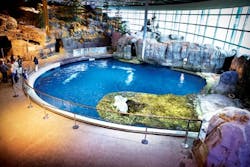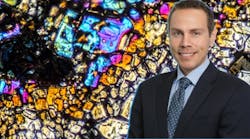The average American family of four uses 400 gal of water per day, according to the U.S. Environmental Protection Agency, or 146,000 gal per year. In 2007, Chicago’s Shedd Aquarium was blowing through nearly 58 million gal per year.
By itself, the aquarium’s Oceanarium—its largest exhibit—holds 3 million gal of water. The entire building requires water for cooling the animals’ habitats; controlling pH; unclogging filters; flushing the toilets; and running the faucets in the bathrooms.
For the past decade, the aquarium has been engaged in the formidable task of cutting that 58-million-gal yearly water expenditure in half—a task complicated by the fact that “different species of animals have to live in different types of water environments; it’s more complex than just not using too much water, because they have to treat water and treat animals in many different ways,” said Carol Ronen, a consultant at Shedd who has assisted the aquarium in its energy conservation efforts.
And, incredibly, those efforts are succeeding.
A rainwater capture system on the aquarium’s roof catches water for use in its cooling tower.
‘Kind of a Big Deal’
Shedd’s ultimate goal is to reduce its water use 50% from the 2007 baseline of approximately 58 million gal by the year 2018. With the way events have unfolded in 2016, “we’re going to be at that 50%,” said Bob Wengel, vice president of facilities for the aquarium and the person who has spearheaded its conservation efforts. “We’re about 750,000 gal ahead of last year.”
“If you think about it, you go from a place in 2007 that used 60 million gal of water to a place in 2016, nine years later, and you’re using 30 million gal—and oh, by the way, we’re an aquarium and water is our business—it’s kind of a big deal,” Wengel said.
To conserve water, Wengel first addressed what he calls “the low-hanging fruit—flush toilet valves, sensors on sinks, low-flow sinks, that kind of thing.”
Then there were the bigger projects. For years, the aquarium relied on city water for condensing refrigeration systems and was reluctant to replace these systems simply because they had been in use for so long.
When a 2009 water use audit identified the chilling system as the largest water user in the aquarium building, it was time to find alternatives. The cooling tower and chillers were replaced with a high-efficiency system, and a closed-loop condenser system was installed to recycle water through the chillers. Finally, the aquarium installed a rainwater capture system on the roof for use in the cooling tower.
“You can say things are grandfathered in, but just because it’s grandfathered, doesn’t mean it’s right,” Wengel said of the condenser system replacement. “You’ve got to ask yourself all of these really hard questions.”
The 2008 renovation of the aquarium’s Oceanarium marked another conservation triumph, allowing Shedd to reuse water from the shark and reef systems in the Oceanarium, rather than creating its own saltwater from freshwater on-site—thereby saving upwards of 2 million gal per year.
Other projects include replacing the reserve system and installing a closed-loop saltwater system in the penguin enclosure; replacing the reverse osmosis (RO) filtration system in the Amazon Rising exhibit; and reusing wastewater from the latter exhibit for backwashing.
Below the Threshold
Cutting 5 or 10 million gal off of a 59-million-gal-per-year water expenditure? Easy, according to Wengel. But “as we went on, things got harder, because you don’t have as many opportunities,” he said. “If you want to go below 50%, it’s like squeezing the last juice out of a lemon.”
Wengel’s recent conservation projects are not large-scale renovation endeavors like retrofitting the Oceanarium. Undertakings on that scale are “harder problems to solve that need some research, some science—a lot more studying,” he said. Rather, his latest efforts entail making smaller changes that, over time, add up to water savings. One example of this is Wengel’s recent experiments with backwashing.
“Take a couple of filters that you might backwash two or three times a week, but take a minute out of the backwash cycle. That minute adds up to a lot of water over the course of the year, and it doesn’t affect the system at all,” he said.
Getting the Message
While its water conservation efforts are impressive, they generally are not named among the highlights of guests’ visits to Shedd. Not when one can observe the green sea turtle eating from a diver’s hand in the Caribbean Reef; meet the Pacific white-sided dolphins, sea otters, belugas and other marine mammals that populate the Oceanarium; and pet the stingrays at the Stingray Touch exhibit.
“What’s interesting about sustainability, and particularly water conservation, is that it’s not top of mind for people when they visit the aquarium,” said Aislinn Gauchay, Shedd’s assistant director of Great Lakes and Sustainability. “They’re seeing the animals, they’re aware of the habitats that require water to run, but the scope of that work is just something that they can’t see unless we tell them that specific story.”
It is up to Gauchay and her team to communicate the story of Shedd’s sustainability initiatives to the public—not only to gain public support, but also to inspire its audience’s own sustainability efforts. To do so, Shedd includes sustainability oriented videos prior to shows in the Oceanarium and has installed an interactive kiosk in the aquarium’s Oceans gallery where guests can learn water-saving tips such as shortening their showers, turning water off when brushing their teeth, and doing full loads of laundry and dishes.
“I never like to talk about things in a vacuum,” Gauchay said. “When we’re sharing the successes and the innovations that Shedd has, it’s never intended to be, ‘Yay, Shedd!’ What we want to do is give people an example of the kinds of things that they could be doing.
“All of our water successes came from questioning the status quo. Saying, ‘How can we do better?’ If each of us asks that question of ourselves, we could all make a very big impact.”


